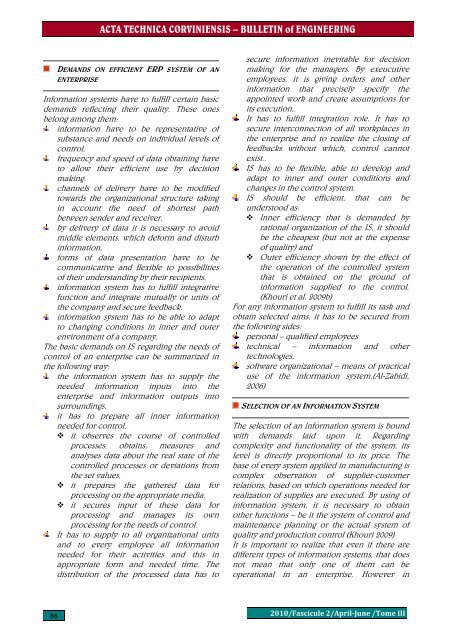ACTA TECHNICA CORVINIENSIS - Bulletin of Engineering
ACTA TECHNICA CORVINIENSIS - Bulletin of Engineering
ACTA TECHNICA CORVINIENSIS - Bulletin of Engineering
- No tags were found...
You also want an ePaper? Increase the reach of your titles
YUMPU automatically turns print PDFs into web optimized ePapers that Google loves.
<strong>ACTA</strong> <strong>TECHNICA</strong> <strong>CORVINIENSIS</strong> – BULLETIN <strong>of</strong> ENGINEERINGDEMANDS ON EFFICIENT ERP SYSTEM OF ANENTERPRISEInformation systems have to fulfill certain basicdemands reflecting their quality. These onesbelong among them:information have to be representative <strong>of</strong>substance and needs on individual levels <strong>of</strong>control,frequency and speed <strong>of</strong> data obtaining haveto allow their efficient use by decisionmaking,channels <strong>of</strong> delivery have to be modifiedtowards the organizational structure takingin account the need <strong>of</strong> shortest pathbetween sender and receiver,by delivery <strong>of</strong> data it is necessary to avoidmiddle elements, which deform and disturbinformation,forms <strong>of</strong> data presentation have to becommunicative and flexible to possibilities<strong>of</strong> their understanding by their recipients,information system has to fulfill integrativefunction and integrate mutually or units <strong>of</strong>the company and secure feedback,information system has to be able to adaptto changing conditions in inner and outerenvironment <strong>of</strong> a company.The basic demands on IS regarding the needs <strong>of</strong>control <strong>of</strong> an enterprise can be summarized inthe following way:the information system has to supply theneeded information inputs into theenterprise and information outputs intosurroundings,it has to prepare all inner informationneeded for control, it observes the course <strong>of</strong> controlledprocesses, obtains, measures andanalyses data about the real state <strong>of</strong> thecontrolled processes or deviations fromthe set values, it prepares the gathered data forprocessing on the appropriate media, it secures input <strong>of</strong> these data forprocessing and manages its ownprocessing for the needs <strong>of</strong> control.It has to supply to all organizational unitsand to every employee all informationneeded for their activities and this inappropriate form and needed time. Thedistribution <strong>of</strong> the processed data has tosecure information inevitable for decisionmaking for the managers. By exeucutiveemployees, it is giving orders and otherinformation that precisely specify theappointed work and create assumptions forits execution,.It has to fulfill integration role. It has tosecure interconnection <strong>of</strong> all workplaces inthe enterprise and to realize the closing <strong>of</strong>feedbacks without which, control cannotexist..IS has to be flexible, able to develop andadapt to inner and outer conditions andchanges in the control system.IS should be efficient, that can beunderstood as: Inner efficiency that is demanded byrational organization <strong>of</strong> the IS, it shouldbe the cheapest (but not at the expense<strong>of</strong> quality) and Outer efficiency shown by the effect <strong>of</strong>the operation <strong>of</strong> the controlled systemthat is obtained on the ground <strong>of</strong>information supplied to the control.(Khouri et al. 2009b)For any information system to fulfill its task andobtain selected aims, it has to be secured fromthe following sides:personal – qualified employeestechnical – information and othertechnologies,s<strong>of</strong>tware organizational – means <strong>of</strong> practicaluse <strong>of</strong> the information system.(Al-Zabidi,2006)SELECTION OF AN INFORMATION SYSTEMThe selection <strong>of</strong> an information system is boundwith demands laid upon it. Regardingcomplexity and functionality <strong>of</strong> the system, itslevel is directly proportional to its price. Thebase <strong>of</strong> every system applied in manufacturing iscomplex observation <strong>of</strong> supplier-customerrelations, based on which operations needed forrealization <strong>of</strong> supplies are executed. By using <strong>of</strong>information system, it is necessary to obtainother functions – be it the system <strong>of</strong> control andmaintenance planning or the actual system <strong>of</strong>quality and production control (Khouri 2009)It is important to realize that even if there aredifferent types <strong>of</strong> information systems, that doesnot mean that only one <strong>of</strong> them can beoperational in an enterprise. However in862010/Fascicule 2/AprilJune /Tome III
















